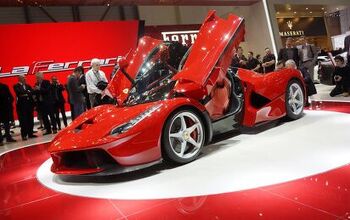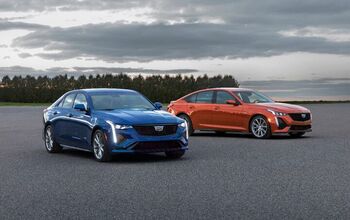Freedom From Choice
In 1817, Marie-Henri Beyle toured the Uffizi museum. Lost in a maze of galleries, the French novelist was paralyzed by indecision. His heart raced. His breathing was shallow and labored. His mind was completely disoriented. He couldn't move. Beyle eventually wrote about his experience under his pen name, Stendahl. In 1979, Italian psychiatrist Graziella Megherini coined the phrase 'Stendahl Syndrome' for people paralyzed by excessive choice. It's a concept bedeviling supermarkets, web pages and… carmakers.
For example, BMW's M5 is considered the ultimate sports sedan. And yet the uber-5er faces a bewildering range of operational decisions: three suspension, shifting and e-traction levels; two horsepower options and eleven gearbox modes. While a hard-core cadre of enthusiasts embrace the Bimmer's programmability, most newbies sit in the M5's driver's seat and… freeze. After overcoming their initial shock, they rely on one or two factory settings– or walk away thanking Gott in Himmel they own something a lot less complicated.
The M5's complexity reflects automakers' overly literal interpretation of America's favorite shibboleth: freedom of choice. Carmakers clearly believe that the more their products cater to each owner's personal preferences, the better. You only have to count the number of motors underneath a S-Class' seat– or tally-up the number of ways it can massage, heat or cool its occupant's hindquarters– to see the philosophy in action. And it's not just the luxury playas kissing ass. Even a humble Hyundai Elantra offers eight-way adjustable seats. This sort of multi-variable "feature creep" is spreading through the automotive landscape like electronic kudzu.
The personalization craze is based on a couple of false assumptions. For one thing, it assumes that people are different. As much as purple dinosaurs would have us believe otherwise, most humans share the same likes and dislikes. Put an Audi MMI interface in front of a wealthy, middle-aged man, and he'll use it (or not) the same way as any other wealthy, middle-aged man: completely ignoring 80% of its functions. If middle-aged men are your core clientele, confronting them with options they don't want or (worse) understand is an indisputably boneheaded idea.
The "options uber alles" movement also assumes that people enjoy experimentation. How do you decide when your M5's chair bolsters should deploy? Which suspension setting is best for the family on a road trip? Technophiles are comfortable "playing" with BMW's buttons until they achieve a suitable result. Regular Joes prefer to leave things as they are (rather than get lost inside an iDrive sub-menu). In both cases, psychological comfort depends on a precise balance between the amount of available choice and a person's ability to understand and evaluate the options. Today's luxury car salesmen spend twice as much time on customer deliveries– explaining functionality– than they did ten years ago. That's a sign of trouble, not progress.
Automotive Stendahl Syndrome isn't restricted to the human – vehicle interface. The industry itself is triggering buyers' instinctual freeze response. Customers must select from literally hundreds of models. Let's say a potential buyer restricts themselves to Ford products. They must then choose from one of eight brands: Ford, Lincoln, Mercury, Mazda, Volvo, Jaguar, Land Rover or Aston Martin. If they take a fancy to Volvo, they must then select a vehicle from eight models: S40, S60, S80, V50, V70, XC70, XC90 or C70. If they opt for an XC90, they then must decide on one of two engine configurations. And then there's the options list… Is it any wonder so many people buy a newer version of their existing whip, rather than face the prospect of Stendahl Syndrome?
Automakers looking to increase customer satisfaction and build their brands should buck the trend and implement a radical, counterintuitive strategy: less choice. First, they must only offer the options and features their core clients really need/want (erring on the side of minimalism). Second, they must make all in-car functions completely intuitive. Third, they must realize that customers are most comfortable choosing between two– count 'em two– options (e.g. heated seat: on or off). Fourth, they should never offer a customer more than three choices for adjusting an in-car device (e.g. driving character: comfort, sport or extreme).
Here's the really tough part: carmakers should only sell three models per brand. I know it sounds crazy, but the average luxury buyer has a better chance of naming the staff at their local Starbuck's than listing Cadillac's entire lineup. By the same token, back in the days when a VW was a Beetle and a bus, the automaker's image was far stronger than it is today. By simplifying their products and scything their range, carmakers would eliminate Stendahl Syndrome, making it easier for customers to choose and enjoy their car. Any way you look at it, that's got to be a good thing.
More by Robert Farago
Latest Car Reviews
Read moreLatest Product Reviews
Read moreRecent Comments
- Analoggrotto I don't see a red car here, how blazing stupid are you people?
- Redapple2 Love the wheels
- Redapple2 Good luck to them. They used to make great cars. 510. 240Z, Sentra SE-R. Maxima. Frontier.
- Joe65688619 Under Ghosn they went through the same short-term bottom-line thinking that GM did in the 80s/90s, and they have not recovered say, to their heyday in the 50s and 60s in terms of market share and innovation. Poor design decisions (a CVT in their front-wheel drive "4-Door Sports Car", model overlap in a poorly performing segment (they never needed the Altima AND the Maxima...what they needed was one vehicle with different drivetrain, including hybrid, to compete with the Accord/Camry, and decontenting their vehicles: My 2012 QX56 (I know, not a Nissan, but the same holds for the Armada) had power rear windows in the cargo area that could vent, a glass hatch on the back door that could be opened separate from the whole liftgate (in such a tall vehicle, kinda essential if you have it in a garage and want to load the trunk without having to open the garage door to make room for the lift gate), a nice driver's side folding armrest, and a few other quality-of-life details absent from my 2018 QX80. In a competitive market this attention to detai is can be the differentiator that sell cars. Now they are caught in the middle of the market, competing more with Hyundai and Kia and selling discounted vehicles near the same price points, but losing money on them. They invested also invested a lot in niche platforms. The Leaf was one of the first full EVs, but never really evolved. They misjudged the market - luxury EVs are selling, small budget models not so much. Variable compression engines offering little in terms of real-world power or tech, let a lot of complexity that is leading to higher failure rates. Aside from the Z and GT-R (low volume models), not much forced induction (whether your a fan or not, look at what Honda did with the CR-V and Acura RDX - same chassis, slap a turbo on it, make it nicer inside, and now you can sell it as a semi-premium brand with higher markup). That said, I do believe they retain the technical and engineering capability to do far better. About time management realized they need to make smarter investments and understand their markets better.
- Kwik_Shift_Pro4X Off-road fluff on vehicles that should not be off road needs to die.


































Comments
Join the conversation